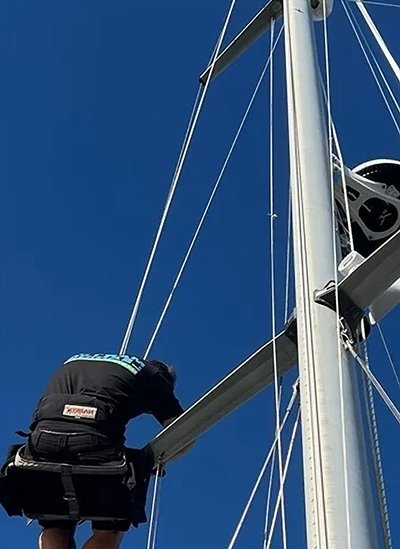Giving you peace of mind about the safety and performance of your boat

We provide a thorough rig inspection service that aims to find faults such as stress cracking or worn parts and also check for general wear and tear.
Any faults or potential failures will be reported back to you in the form of a written rig report with relevant images of any areas identified as requiring attention.
Something we hear a lot: after we do a rig check, people feel so much better about their boat. It’s like a weight’s been lifted.
Especially if you’re out there with family or heading off on a long trip—you want to know everything’s in good shape.
It’s all about peace of mind so you can just enjoy the ride, knowing you’re good to go.
All those rigging parts—wires, swages, fittings—are going wear out eventually. It’s just inevitable when they’re exposed to salt, sun, and stress. But here’s the thing: regular checks and keeping your mast properly tuned can help your rig last a lot longer. If you’re over-tightening things, you’re just putting unnecessary pressure on the mast and the whole boat, and that can lead to some early breakdowns. If it’s too loose, though, you’re asking for more wear and tear, and it’ll wear out way faster than it should. Keep it balanced, and it’ll last!
A well-tuned rig makes all the difference when you’re out on the water. If your rigging’s loose or out of whack, it can mess with your boat’s sailing efficiency—or even make your furler act up. Nobody wants that. So, checking your rig regularly ensures you’re getting the most out of it, whether you’re racing or cruising. A properly tuned rig means you can focus on sailing, not wondering if something’s going wrong.
What's involved in a Rig Inspection?
Here’s a quick run down of what we look for:
- Cracks, dents, rust, or anything that looks off on the mast. Make sure the mast step is secure.
- Wear, corrosion, or broken strands in your wires. Check that all fittings are tight and aligned.
- Chafing or fraying on lines. Make sure everything runs smoothly through the blocks and pulleys.
- Look for cracks, bends, or corrosion, and make sure spreader tips are secure.
- Damage to the boom, and we make sure sheaves rotate freely. Check for corrosion where different metals meet.
- Chainplates and other deck fittings that show wear or corrosion.
- Tension is within the recommended range, and the mast has the right rake and bend.
Please get in touch to arrange your Rig Inspection.
